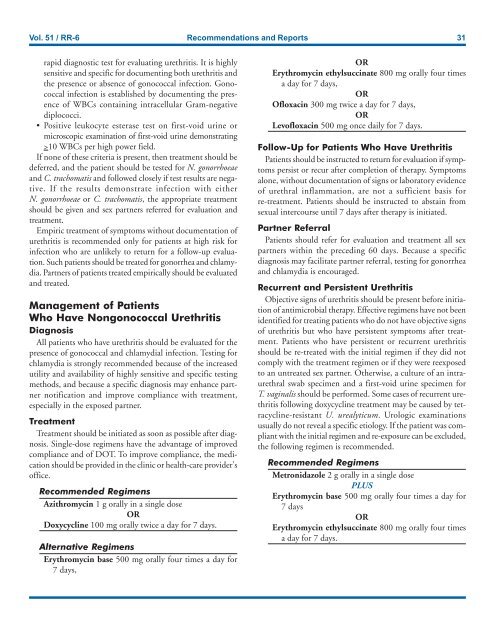You also want an ePaper? Increase the reach of your titles
YUMPU automatically turns print PDFs into web optimized ePapers that Google loves.
Vol. 51 / RR-6 Recommendations and Reports 31<br />
rapid diagnostic test for evaluating urethritis. It is highly<br />
sensitive and specific for documenting both urethritis and<br />
the presence or absence of gonococcal infection. Gonococcal<br />
infection is established by documenting the presence<br />
of WBCs containing intracellular Gram-negative<br />
diplococci.<br />
Positive leukocyte esterase test on first-void urine or<br />
microscopic examination of first-void urine demonstrating<br />
>10 WBCs per high power field.<br />
If none of these criteria is present, then treatment should be<br />
deferred, and the patient should be tested for N. gonorrhoeae<br />
and C. trachomatis and followed closely if test results are negative.<br />
If the results demonstrate infection with either<br />
N. gonorrhoeae or C. trachomatis, the appropriate treatment<br />
should be given and sex partners referred for evaluation and<br />
treatment.<br />
Empiric treatment of symptoms without documentation of<br />
urethritis is recommended o<strong>nl</strong>y for patients at high risk for<br />
infection who are u<strong>nl</strong>ikely to return for a follow-up evaluation.<br />
Such patients should be treated for gonorrhea and chlamydia.<br />
Partners of patients treated empirically should be evaluated<br />
and treated.<br />
Management of Patients<br />
Who Have Nongonococcal Urethritis<br />
Diagnosis<br />
All patients who have urethritis should be evaluated for the<br />
presence of gonococcal and chlamydial infection. Testing for<br />
chlamydia is strongly recommended because of the increased<br />
utility and availability of highly sensitive and specific testing<br />
methods, and because a specific diagnosis may enhance partner<br />
notification and improve compliance with treatment,<br />
especially in the exposed partner.<br />
Treatment<br />
Treatment should be initiated as soon as possible after diagnosis.<br />
Single-dose regimens have the advantage of improved<br />
compliance and of DOT. To improve compliance, the medication<br />
should be provided in the clinic or health-care provider’s<br />
office.<br />
Recommended Regimens<br />
Azithromycin 1 g orally in a single dose<br />
OR<br />
Doxycycline 100 mg orally twice a day for 7 days.<br />
Alternative Regimens<br />
Erythromycin base 500 mg orally four times a day for<br />
7 days,<br />
OR<br />
Erythromycin ethylsuccinate 800 mg orally four times<br />
a day for 7 days,<br />
OR<br />
Ofloxacin 300 mg twice a day for 7 days,<br />
OR<br />
Levofloxacin 500 mg once daily for 7 days.<br />
Follow-Up for Patients Who Have Urethritis<br />
Patients should be instructed to return for evaluation if symptoms<br />
persist or recur after completion of therapy. Symptoms<br />
alone, without documentation of signs or laboratory evidence<br />
of urethral inflammation, are not a sufficient basis for<br />
re-treatment. Patients should be instructed to abstain from<br />
sexual intercourse until 7 days after therapy is initiated.<br />
Partner Referral<br />
Patients should refer for evaluation and treatment all sex<br />
partners within the preceding 60 days. Because a specific<br />
diagnosis may facilitate partner referral, testing for gonorrhea<br />
and chlamydia is encouraged.<br />
Recurrent and Persistent Urethritis<br />
Objective signs of urethritis should be present before initiation<br />
of antimicrobial therapy. Effective regimens have not been<br />
identified for treating patients who do not have objective signs<br />
of urethritis but who have persistent symptoms after treatment.<br />
Patients who have persistent or recurrent urethritis<br />
should be re-treated with the initial regimen if they did not<br />
comply with the treatment regimen or if they were reexposed<br />
to an untreated sex partner. Otherwise, a culture of an intraurethral<br />
swab specimen and a first-void urine specimen for<br />
T. vaginalis should be performed. Some cases of recurrent urethritis<br />
following doxycycline treatment may be caused by tetracycline-resistant<br />
U. urealyticum. Urologic examinations<br />
usually do not reveal a specific etiology. If the patient was compliant<br />
with the initial regimen and re-exposure can be excluded,<br />
the following regimen is recommended.<br />
Recommended Regimens<br />
Metronidazole 2 g orally in a single dose<br />
PLUS<br />
Erythromycin base 500 mg orally four times a day for<br />
7 days<br />
OR<br />
Erythromycin ethylsuccinate 800 mg orally four times<br />
a day for 7 days.


